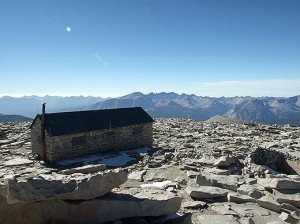The Mount Whitney Hut Turns 100
/https://tf-cmsv2-smithsonianmag-media.s3.amazonaws.com/filer/78-6565.jpg)
A convergence of rather significant, albeit obscure, anniversaries are at hand. One being the 400th anniversary of Galileo's demonstration of the telescope, which took place on Tuesday of this week and the other is today's 100th anniversary of the completion a stone hut that Smithsonian astronomers built on the top of California's Mount Whitney in 1909.
The stone hut now serves as a shelter for weary climbers who summit the 14,502-foot-high mountain located in Sequoia and Kings Canyon National Parks. But 100 years ago, before rocketry afforded space telescopes, the tiny astronomical outpost represented the pinnacle of scientific endeavors. The hope was that from observations made here, high enough to escape much of Earth's atmosphere, the researchers would be able to detect the existence of water, if not life, on Mars.
So donkeys carrying heavy loads of people and supplies were coaxed up the steep, rocky mountain trail and the little three-room hut, measuring 11 by 30 feet, was painstakingly erected within about four weeks. Wrote one observer: "The structure is composed of stone, cement, steel and glass, with not a stick of wood in it."
The hut was immediately equipped with a telescope, just as Galileo had done 300 years earlier. "Our instruments consisted of a sixteen-inch horizontal reflecting telescope and a suitable spectroscope connected with it. It was necessary to protect all parts from the wind, and a canvas shelter was constructed to enclose the instruments," the expedition leader wrote.
Stormy weather had made the journey up the mountain long and difficult and of the seven nights that the expedition remained at the top in the bitter cold, only two nights were clear enough for observations. But the scientists remained hopeful. Their method was to compare the spectrum of the moon, which they knew had no water, to that of Mars. "We are now in a position to issue the strongest statement that has ever been issued as to the existence of water vapor on Mars." (Scientists only recently confirmed water in the form of ice at the planet's poles, and say that water is trapped under the surface—either as ice or liquid.)
In 1977, the Mount Whitney Smithsonian Institution Shelter was listed in the National Register of Historic Places. Today, the hut is no longer a Smithsonian outpost. Instead, it keeps lonely vigil there at the top of the continental United States' highest elevation point. Wrote one climber who recently spent the night in the hut: "The wind whistled throughout the inside of the shelter all night, and time went by very slowly."
As for anniversaries, more are certain to come. In 1909, the director of the Lick Observatory told the New York Times that the hut "should last 500 years."
(A celebration of the Mount Whitney Hut's anniversary is planned for Thursday at 10 a.m. at the Whitney Portal Day Use Area, located 13 miles west of Lone Pine at the end of Whitney Portal Road. Park officials warn that parking is limited and recommend carpooling.)
/https://tf-cmsv2-smithsonianmag-media.s3.amazonaws.com/accounts/headshot/Beth_Head_Shot_High_Res-14-v2.png)

/https://tf-cmsv2-smithsonianmag-media.s3.amazonaws.com/accounts/headshot/Beth_Head_Shot_High_Res-14-v2.png)